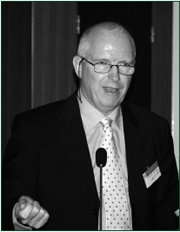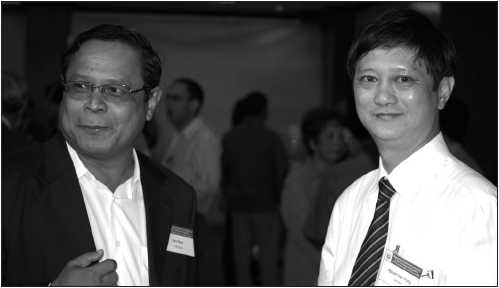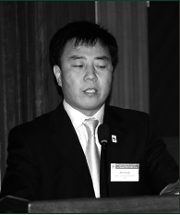Fish migration emerges as key issue at
regional hydropower conference
With preliminary information on most mainstream dam proposals already available, stakeholders are now seeking an integrated basin-wide approach to the sensitive issue of hydropower development in the Lower Mekong Basin
Senior officials from the Cambodian, Lao, Thai and Vietnamese governments gathered in Vientiane in September for a two-day conference on the MRC's new Hydropower Programme. Officials from China also took part along with engineers, bankers, ecologists and members of civil society. Financed by Japan's ASEAN Integration Fund, the "regional multi-stakeholder consultation" was the first of its kind with almost 200 delegates attending. Chaired by Lao National Mekong Committee Director General Chantavong Saignasith, the conference featured speakers from all MRC governments as well as the International Hydropower Association, the WorldFish Centre, the World Bank, the Asian Development Bank (ADB), the World Wildlife Fund (WWF) and the United States Army Corps of Engineers. Presentations were also made by China's Sinohydro Corp, France's Compagnie Nationale du Rhône, the NGO Forum of Cambodia and International Rivers, an advocacy non-governmental organisation based in California.
In addition to helping to design the new Hydropower Programme, MRC Chief Executive Officer Jeremy Bird told delegates that the consultation aimed to raise awareness of different perspectives and common interests related to hydropower development. Above all, however, it was an opportunity for stakeholders to meet and build trust. "This will be important in the future when inter-governmental discussions on mainstream dams will need to ensure their contribution to the sustainable use of resources in the basin," he said in an opening address. Mr Bird acknowledged Fish migration emerges as key issue at regional hydropower conference that dams were sensitive. "Sensitivity, however, is not a reason to avoid engagement on the subject," he added, noting that greater openness and discussion could improve outcomes. "Many of the good-practice examples being implemented on the Nam Theun 2 project, for example, are a direct result of a more open planning process which involved listening to a broad range of views."
Mr Bird said that preliminary information on most of the proposed mainstream dam projects had already been shared among the four MRC countries, and that notification and prior consultation would begin in the coming months. "As notification of projects will be made at different times, it is important to have an integrated basin-wide assessment framework," he said. As an example of such an integrated approach, Mr Bird noted that the MRC was already helping the Lao government to study ways to optimise the benefits of proposed dams in the upper part of the basin as a whole rather than letting developers maximise production from indivual projects independently. He also highlighted the role of the MRC's Fisheries Programme in examining technical options and likely survival rates for fish to migrate through dam obstructions. "The fisheries issue, let us be clear, goes beyond biodiversity," he said. "It is at the heart of people's subsistence livelihoods."

Dr Patrick Dugan of WorldFish Center
Photo: Lem Chamnap
The main presentation on fisheries was delivered by Dr Patrick Dugan, Deputy Director General of the WorldFish Center who reported on a two-day meeting of independent experts to examine the barrier effects of mainstream dams on fish migration in the Mekong. Held immediately before the conference, this separate meeting convened by the MRC in Vientiane brought together 17 biologists, ecologists and engineers who have been working to reduce the impacts of dams on fisheries in various river systems around the world. In his presentation to the broader conference, Dr Dugan discussed the importance of fish migration for fisheries production in the Lower Mekong Basin, the effects of dams on these migratory species, and the possible options for mitigation (for a detailed account of the expert group meeting, see Dr Dugan's article starting on page 9).
In a separate presentation, Dr Bolyvong Tanovan of the United States Army Corps of Engineers, highlighted the importance of integrating mitigation measures into projects at an early stage. Over the past two decades, he noted that power operations on the Columbia River had been constrained by conservation listings for several species of salmon and trout. As a result, energy production of 1,000 megawatts a year had been foregone in order to prioritise fish passage. Dr Bolyvong, chief of the water management power branch of the Army Corps of Engineers northwest division, also noted that the annual fish mitigation costs for the Columbia River had ballooned from $40 million in 1978 to $500 million in 2004, amounting to $9 billion to date. By 2004, fish mitigation costs represented 16 percent of the revenues of the Oregon-based Bonneville Power Administration, a federal agency under the Department of Energy. These costs were expected to range from $80 million to $130 million a year over the next five years.

Dr Bolyvong Tanovan of the United
States Army Corps of Engineers
Photo: Lem Chamnap
The preparation of the MRC's new Hydropower Programme coincides with increased interest in hydropower development to meet rapidly-growing demand for energy in the Mekong region. Developers have been considering many potential projects and negotiations on several concessions are already at an advanced stage. In addition to dams on tributaries, these include projects across the mainstream of the Mekong River. Until now, the only mainstream dams on the river have been in the Upper Mekong Basin in China. Mainstream projects in downstream countries are, however, now more viable due to high oil prices and new dams in China which will result In increased water flows downstream during the dry season. Concern over climate change has also made hydropower more attractive as a source of energy. The proposed mainstream projects in the lower basin would have an installed capacity of more than 14,000 megawatts, similar to the combined capacity of existing mainstream dams or those either under construction or planned in China. That's equivalent to more than four times the capacity of existing hydropower projects on tributaries in the lower basin.
Recent efforts to formulate the Hydropower Programme follow the signing of a four-year agreement with Finland worth US$2.87 million late last year. The four MRC countries already have a regional Hydropower Strategy approved in 2001 and an outline for a Hydropower Programme approved in 2005. Under the outline, the Fisheries Programme has been learning more about the impact of dams on fish migration, spawning and production. The Environment Programme has been assessing environmental and social impacts, especially across borders. The Basin Development Plan Programme has been assessing the cumulative impacts of dams on water flows, sedimentation and water quality. And in a joint initiative with the ADB and WWF, the MRC last year published a technical report on environmental criteria for hydropower development in the Mekong region. The report found that Bhutan's sectoral guidelines for hydropower seemed to be suitable for preliminary screening in the Mekong region but would be difficult to use in comparing slightly different proposals. Of the three international environmental criteria frameworks reviewed, the sustainability guidelines of the International Hydropower Association were found to be the most comprehensive and possible best starting point for the Greater Mekong Subregion. Before embarking on major investments, the report found advantages in moving away from assessing individual projects towards strategic environmental assessments of cumulative or basinwide impacts.
Dr Ma Chaode of WWF China
Photo: Lem Chamnap
As the Hydropower Programme takes shape, the MRC has proposed a two-track approach. The first aims to improve understanding about the regional implications of hydropower development in the short term. The main focus will be on to what extent the negative impacts of the barrier effect of mainstream dams can be minimised or mitigated. According to a preliminary draft programme document circulated at the September conference, this is "one of the most important questions facing mainstream hydropower development." The conclusions of the meeting of 17 experts will therefore be valuable information for regional planning discussions regarding economic growth, poverty reduction and sustaining the environmental services of the river as hydropower projects are developed.
The second track will take a longer-term approach and will require more detailed work in areas ranging from environmental and social issues to the development of standards for navigation locks. Spread over two years starting in September, the second track will include various levels of dialogue between policymakers as well as private-sector developers, financiers and civil society. The MRC will also convene regular multistakeholder consultations similar to the conference in September and continue its dialogue with China as both an upstream partner and as a sponsor of projects in the lower basin.The programme is expected to be overseen by a Hydropower Advisory Board comprising representatives of National Mekong Committees and senior officials from line agencies. The estimated budget for the programme is between $6 and $7 million between 2008 and 2011.

Dr Sam Nuov, Deputy Director of the
Cambodian Fisheries Administration, and Mr Nguyen Van Trong,
Deputy Director of the Vietnamese Research Institute for Aquaculure
No. 2, during a break in the conference.
Photo: Lem Chamnap
Further reading
King, Peter, J Bird and L Haas (2007). The Current Status of Environmental Criteria for Hydropower Development in the Mekong Region: A Literature Companion, Asian Development Bank, Mekong River Comission Secretariat and WWF, Vientiane
Mekong River Commission (2008). Draft Programme Document, Hydropower Programme, MRC, Vientiane (www.mrcmekong,org/ programmes/hydropower.htm)
Choose a newsletter:
